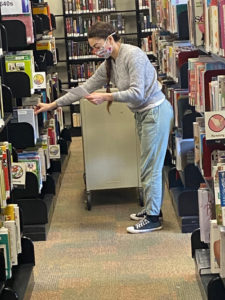Contra Costa libraries to open April 26 with ‘temporary’ service options

CONTRA COSTA COUNTY, CA — A safe environment is priority one as nearly all Contra Costa County library branches prepare to reopen April 26 with regular hours for the first time in over a year.
The hallmark of the effort is a Grab and Go program that emphasizes visits of no more than one hour either for browsing for books or using an available computer.
County librarian Alison McKee does not see the reopening as “a new normal” for the system.
“The libraries are going to look and feel a little differently at first, but this is a temporary change to library services,” she said. “We have made every effort to prepare our libraries for reopening with as many services as possible while providing an environment that is safe for patrons and staff.”
McKee declined to speculate on any further adjustments and when they might occur.
“We will continue to increase capacity based on the tier system from the state’s Blueprint for a Safer Economy. We will add more services as the county health officer and the county administrator’s office advises,” she said.
Services available as part of the Grab & Go model include browsing the shelves, picking up and checking out holds, signing up for a library card, reference help and account services, and copying. Public computers will also be available with a one-hour limit. Patrons can self-check at every open library.
Due to size limitations, the Crockett and Rodeo libraries will continue to offer Front Door Service only. And the Ygnacio Valley and Pinole branches remain shuttered for use as COVID-19 testing sites.
Putting safety first

Mask requirements will be enforced, as well as additional safety enhancements including plexiglass at service desks, enhanced cleaning of “high-touch” surfaces such as doorknobs, door push bars and elevator buttons and increases to air intake with HVAC systems.
“I think our patrons are already prepared. We have all been living through this pandemic for over a year. We are all used to social distancing, masks and changes to services,” said McKee. “In the libraries, we are going to focus on providing a high level of customer service and meeting the needs of our communities in a safe environment.”
The occupancy levels will vary from one branch to another, and the number to be allowed in will be posted on the front entrance of each site. Similarly, the number of computers available will vary by location.
Increase in digital services
McKee and her staff readied for this reopening by speaking with library representatives from around the country to gauge what they had experienced with their communities.
“We expect the libraries to stay below capacity for a while because many people do not feel comfortable coming inside buildings yet,” McKee said.
While not going as far as to say the pandemic may have forever changed the role of the library, she acknowledged the county’s system has made many adjustments that the public has come to embrace.
“Though our circulation of physical materials is down, the numbers for digital circulation are way up. In 2020, we saw more than one million digital checkouts for the first time. We also saw huge increases in use of online newspapers, streaming videos and digital magazines,” she said.
The county libraries have offered services via chat, email and over the pphone for years, but McKee reported that requests through these channels have increased in the past year.
The organization has added to its operating budget for digital materials, made it easier to obtain a library card online and, in general, worked with many of its partners to feature more digital services for use from home that once were only available in the physical libraries.
Complementing the adaption of a wide range of digital offerings was ensuring the staff was prepared for the new demands from the public. They trained personnel on new platforms for creating online programs to accommodate hundreds of recorded videos and live Zoom programs. The system also began lending Wi-Fi hotspots and Raspberry Pis.
“We have seen the value of offering more services online, and we will evaluate which services will continue in the coming months,” McKee said.
Related story: California State Librarian to celebrate Contra Costa County Library reopening
